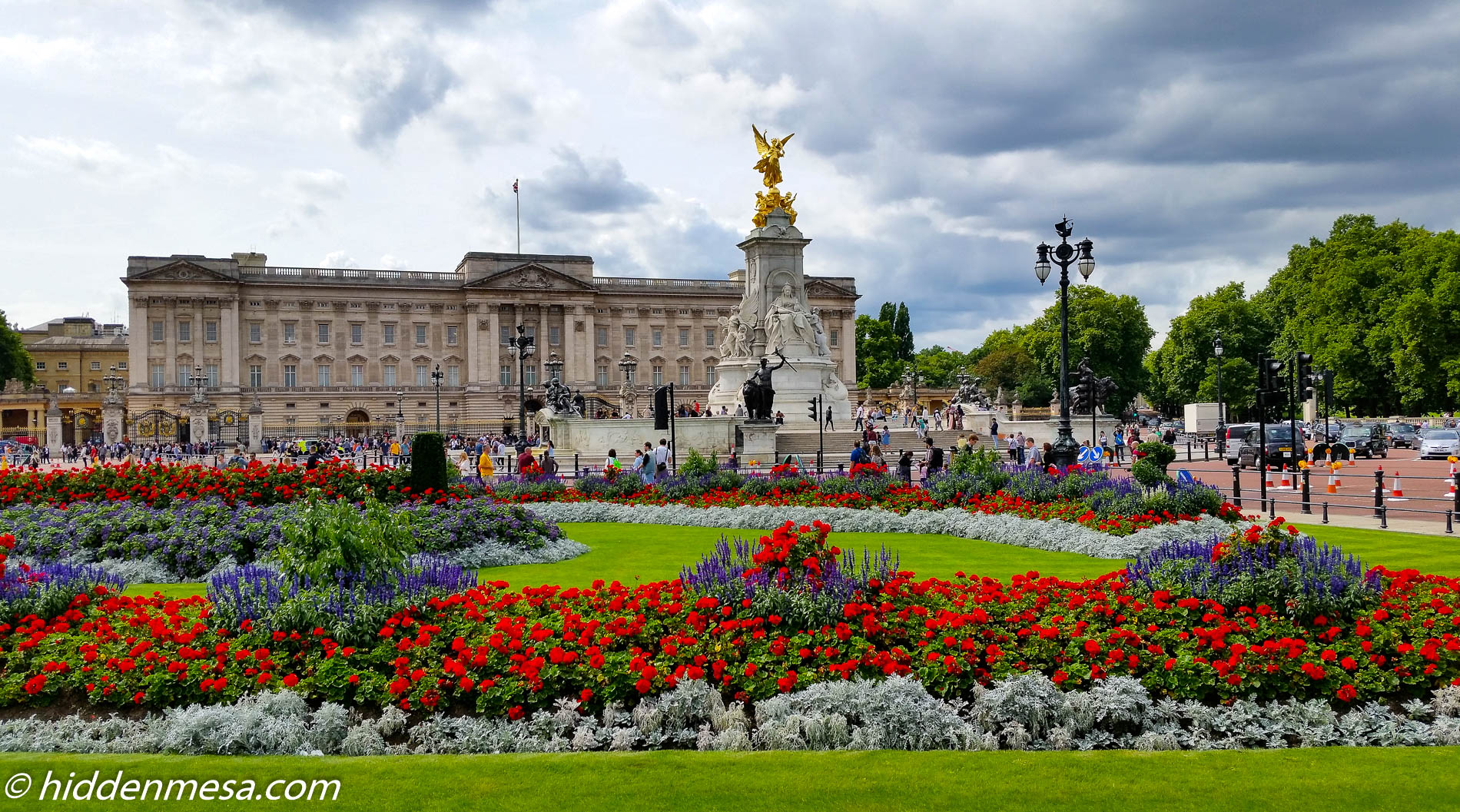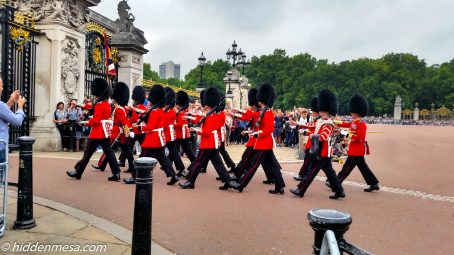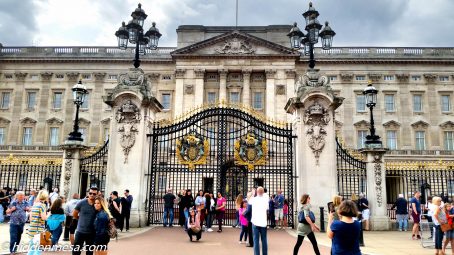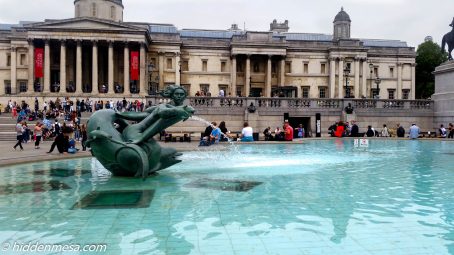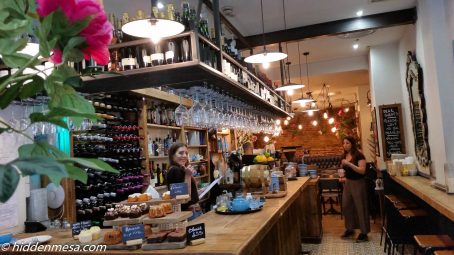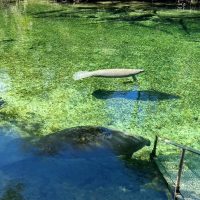We’ve spent the last few days wandering around London, playing American Tourist. For us that means seeking out the Starbucks stores—of which there are many—watching the Changing of the Guards, hanging with the street performers at Trafalgar Square, and so on. Mostly for us, we’ve just been staring at the buildings. Weather has been excellent this trip, so it was a good time to be outside.
London is a busy place. There’s traffic and pedestrians in nearly every square inch of its surface, except possibly the parks, and everything seems to be precisely choreographed and timed. Apparently they are used to foreigners visiting their city because many of the streets even have signs on the pavement telling you which way to look before crossing the street. We found that, like most big cities, ignoring the pedestrian traffic signals could put you in serious peril very quickly if you didn’t understand the flow of traffic. While some folks seemed to be able to judge when to cross the streets, we seemed to have better luck just following the rules.
Since this is our third trip to this vibrant city, we thought we would pass along a few things we’ve learned and observed for those who might be considering a trip to England at some point in the future.
Seeing London for the First Time
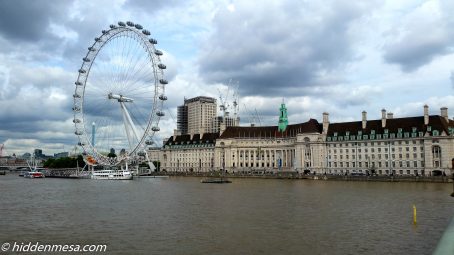
The London Eye. The building behind the London Eye holds gift stores, food courts, the Shrek Adventure, and many more. Photo by Bonnie Fink.
If you’re seeing London for the first time, you might want to stick to the big tourist items: Buckingham Palace, Windsor Castle, Trafalgar Square, Big Ben, and so on. You could pick a tour operator that can take you to these places, or you can simply go, using available transportation, at your own leisure. We’ve done it both ways, and had a good time in each case.
One advantage to using a guided tours is that you don’t need to do your own research to understand what you’re looking at. Also, you have quicker access to places that often require you to stand in line. Windsor Castle comes to mind in particular. You also have access to places out of town, like Stonehenge, or Bath.
Doing your own thing has its advantages too. First, you can do your own research to know what you’re looking at. This often means simply that you slow down a bit and read the signs along the way. If you’re like us and like to take a lot of pictures, doing your own tour means you can spend as much time as you need to get the shot you want. We’ve actually been left behind by tours because we had a lapse in attention while trying to get a good shot. Doing your own thing also means that you can change plans at your whim. You may plan to ride the London Eye today, but it’s overcast, so you go to the Tower of London instead and save the Eye for another day.
Moving around London for us Americans is easy. They speak English. They’re polite. They answer questions. Never despair. Moving around this city is easy and we’ve found it to be a pleasant experience.
Ways to Get Around London
The one way to NOT get around London is to rent a car and try to drive yourself. This is a big city, and it has big city traffic. It also has big city lack of parking. In fact, one thing we see a conspicuous lack of while walking around all the tourist parts of London is parking garages. Not one garage. Nowhere.
There are several effective ways to travel the streets of London:
If you’re reasonably fit, walking is the best way. We spend most of our time walking. Of course, one strategy is to walk till you drop then hail a cab to get back to your hotel. We’ve done that a couple of times, but if you’re planning to hit the main tourist attractions centered around Big Ben, for example, walking is very effective. We carried a good mapping app in our phones, complete with a good data package, and used it on more than one occasion to figure out where we were trying to go.
Taxis are iconic in London. The famous Hackney Carriage (cab, black cab, hack, or London taxi), is the official taxi found in London. These famous vehicles are strictly regulated in terms of vehicle mechanical requirements and driver knowledge. Our information tells us that the drivers pass a rigorous knowledge test before being allowed to drive.
In a previous trip, we stepped into a cab and gave the driver the name of the hotel where we were staying. He didn’t recognize the hotel, but after we gave him the street address, he took us directly to it. The problem was that the hotel was brand new, less than a year old. He knew the street, but didn’t know something had been built in that particular space.
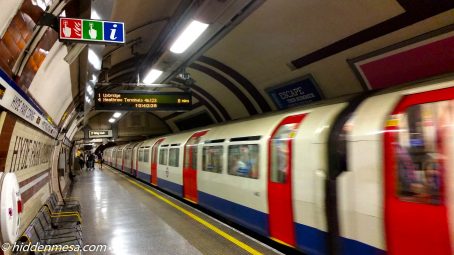
One minor “gotcha” using the Underground in London is that numerous trains may arrive on the same platform. Notice the sign above that shows a train to Uxbridge, which is probably the one arriving now in this image. In eight minutes, the train to Heathrow Terminals 4,1,2, and three will arrive. Photo by Bonnie Fink.
Try the Underground. The subway system in London is extensive. And once you embrace the idea, it’s not all that hard to figure out. In our case, we walked down to a station for the first time after studying maps and getting ready. We bought a ticket by specifying the destination, and the ticket told us what line to get on and what lines to change to. There are nine lines that make up the Underground, so a bit of planning is a good idea. You can buy tickets that substantially reduce the cost to just a few pounds a day for basically unlimited travel.
When we thought about it, the Underground in London was only a little more complicated than the Disney Bus system around Walt Disney World in Orlando. Most of the extra complication comes from the fact that the Underground has multiple payment options, where the Disney transportation system is free. Having been on the Underground exactly once, we’re big fans. Next time we’re in London, we plan to make extensive use of its services.

You can find stands like this all over London, rent a bike for an hour or a day. Photo by Bonnie Fink.
There is an extensive system of public bicycle rentals around London. The cost at the moment seems to be 2 pounds for a 24 hour period, then an additional 2 pounds for each 30 minute period during that 24 hour period while you’re actually using the bicycle. There are maps available that show where to obtain the bike, and where to return it. We weren’t too excited about bicycles as tourists, primarily because we were more interested in walking around, gawking at the incredible architecture, not interacting with heavy traffic that we didn’t fully understand. We thought that the bicycles had potential, but mostly for the more seasoned traveler or the local.
Busses give a couple of options. There’s the hop-on/hop-off, open air, double decker tourist busses that run around to the major tourist stops all over the city. The cost is moderate, at anywhere from 40 pounds to 60 pounds and more, depending on what you decide to do. Truthfully, we didn’t use this service simply because we preferred to walk. We can’t help it. We like walking.
The public busses are another option that tie in with the Underground system. This is of course how a local gets around, and it’s how a local can afford to get around on a regular basis. The public busses seemed to be clean and in good repair, and although we didn’t ride them, it is only because the need didn’t present itself on this last trip. On our next trip, as we embrace the public transportation system more completely, using more flexible payment options, busses could very well be part of our method of expanding our reach as we explore this city.
Where to Stay
We keep talking about how to get around London, and we keep stressing walking. It might be reasonable to understand that in order for this to work, location must be factored into the equation. We’ve stayed in two different hotels in London. The first was a bit out of the way and almost required a cab to get to the usual tourist haunts. The next two times we came here, we stayed in a hotel that was about a mile from Big Ben, maybe a bit less. It was located on the opposite side of the Thames River in the Vauxhall area, the Borough of Lambeth.
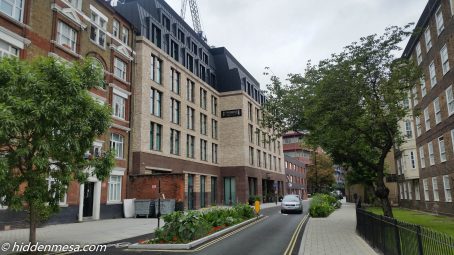
On this quiet little street in the Vauxhall area of London, you’d never guess that there’s a state-of-the-art American style hotel. The building on the left of the vehicle in the street is a Staybridge Suites that’s less than two years old. Free Food, Fast Wifi. All the stuff you expect, and a central location too. Photo by Bonnie Fink.
The last hotel was a Staybridge Suites, which is a chain and part of the Holiday Inn hotels. We like them for lots of different reasons, but in the context of this report, the primary reason was location, followed closely by cost, but mostly location. We would leave the hotel each morning and make our way over to the Thames River and turn left or right, depending on our destination for the day. On one day we were heading to Hyde Park, so we crossed the River at the Vauxhall Bridge and continued down to Wellington Place and Hyde Park. On other days, we would walk along the River Thames and cross at either Big Ben on the Westminster Bridge or at the Golden Jubilee Bridges. Both of these bridges put us in the middle of the tourist action, with Big Ben, Parliament buildings, Trafalgar Square, Buckingham Palace, St. James’s Park, and Hyde Park.
We’re not saying that the Staybridge Suites London-Vauxhall is the best place to stay in London because we’re still relatively new to visiting this town, but it was good enough that we stayed there twice in two years. Next time we might try some place different. We might not. Some of the positives about this hotel are that they operate in much the same way as other Staybridge Suites in the US. There are kitchenettes in the rooms and a Tesco (grocery chain) within easy walking distance, the wifi is good. There’s a free wifi and a paid wifi, like most places in Europe. Since we’re frequent guests in the Holiday Inn bubble, our fancy wifi was at no extra charge. There’s also breakfast in the mornings, like you would expect in a Holiday Inn facility. Rooms were clean and quiet. Actually, our room looked out over the train tracks, and the windows were so good at sound absorption that we were never bothered by the noise. Most of the staff did not speak English as a first language (which seems to be normal in London, New York, Miami, wherever), but they were generally proficient, and always courteous and helpful. The one English word they didn’t seem to know was “no.”
What To Do
It would be silly to pretend that we could make a comprehensive list of things to do in London. There are books on the subject, and when you visit, you should certainly invest in one or more to see what the options are. We’ve made three separate trips to London over the years, and we’ve just touched on the surface of what’s possible, so we can list some of the things we have done so far, and what we would like to do in future trips.
A lot of what we’ve seen here centers around the River Thames, which makes sense because much of the oldest parts of London are near the river. That’s why it was important to us to have a hotel near the river, so we’d be in easy walking distance to the more touristy attractions.
A partial list of sites to see are:
Big Ben
You know the famous bell song from the clock tower. You’ve grown up hearing clocks playing the chimes that emulate Big Ben every quarter hour. There’s just something about standing on the Westminster Bridge and hearing the real deal.
London Eye
It seems like every tourist town has an eye these days, but the London Eye was the first. The view over the Thames river and across to the Government buildings and even St. James’s Park is remarkable. On a clear day, you can see all the way out to Windsor Castle. The Eye holds 800 passengers in its 32 capsules. The 32 capsules, by the way, represent the 32 boroughs that make up London. When the 135 meter tall wheel was built in 1999, it was the tallest Ferris Wheel in the world.
House of Parliament of Westminster
You can book tours on Saturdays and most weekdays during Parliament recess. Here’s a link.
Buckingham Palace
No, you can’t go to London and not see Buckingham Palace. What would you say to your friends? The trick is to see the changing of the guards, and we say trick because it’s not always clear when a guard changing will occur. The best advice we can give is to visit the British Army’s web site. They set the schedule based on a number of factors. The ceremony usually takes place around 11:00 am on Monday, Wednesday, and Friday, but do check the web site for specifics of when you plan to be there. Also, this is an extremely popular event, similar to a popular parade at a Disney park at Walt Disney World. If the changing of the guards is scheduled for 11:00 am, we would suggest that you arrive no later than 10:00 to get a spot next to the fence where you can see the actual ceremony. We were a few dozen rows out from the fence, and while we had a great view of the guards and the band as they approached the Palace, we saw absolutely nothing of the actual ceremony.
Tower of London
Don’t forget the Tower of London. This is where the history of London goes back to as far as 1078, when this fortress was built by William the Conqueror. You could spend an entire day at the Tower of London, or just pop in to see the Crown Jewels.
Changing the Queen’s Life Guards
Another guard change that’s not quite as popular as the main event at Buckingham Palace is the changing of the Queen’s Life Guards, or the Horse Guards. This display originates at Hyde Park Barracks and travels down Constitution Hill in Green Park, The Mall through St James’s Park, and finally to Horse Guard Parade, where a changing ceremony takes place.
Trafalgar Square
One of the more vibrant areas of the city was Trafalgar Square. Named after the Battle of Trafalgar, where Admiral Nelson defeated the Spanish and French in the decisive battle off the coast of Spain. The prominent stature in the square is of course, Admiral Nelson, guarded by four lions. On our latest trip here, we found street performers with the expected crowds. On another visit, we found a rock concert in progress. Still other times, you might encounter a demonstration or rally since this appears to be the symbolic place to hold political, religious, and other demonstrations.
The Parks – In central London, there are many parks that are worth a visit. We spent time in St. James’s Park near Buckingham Palace, and Hyde Park. Both parks have lakes with a considerable number of different bird species. Anything from the common pigeons begging for food to Egyptian Geese, who were also hanging around for a handout. Still, the parks offered a quiet place in the midst of one of the busiest cities we’re visited; a bit of breathing room among the chaos.
What to Eat
We’ve always heard that England is not the place to go if you want good food on a vacation. Our experience has actually been a bit different. As we’ve been moving about the city, and even during some of our trips up into Northern Scotland, we’ve found that finding a pub with good food is quite easy.
During this last stay, we found a couple of pubs that are worthy of mention.
The first is called Villiers. It’s located on Villiers Street, which is near the north side of the Jubilee Bridge, at the Embankment Station for the London Underground. We found this place because it’s right across the street from a Starbucks. We happened to be wandering the street around lunch time, and didn’t think another Double Chocolate Supreme Muffin from Starbucks sounded good for lunch, and there was Villiers, looking inviting and cozy. For those of you who prefer establishments that are not chains, this is it. We each had simple hamburgers, non-alcoholic drinks, and chips (fries). The burgers were excellent, cooked properly, and the wait staff was friendly and prompt. There was a large selection of ales and other drinks, but we can only assume that they were good since Don had a glass of tea and Bonnie tried the bottled Coca-Cola.
The next place we’d like to mention is called The Black Dog. This pub sits in the Vauxhall area, near our Staybridge Suites hotel, and it’s worth visiting even if you’re not staying in the area. If you’re staying in the Staybridge Suites, this could end up being your go-to place to eat. They’re open for breakfast, lunch, and dinner, and stay open late into the evening serving ales and desserts. Something unusual happened during our lunch at the pub: the waiter approached the table and actually served us water. This has never happened before in Europe. Not even in some of the American chains. Then, when Don asked for good ol’ iced tea, the waiter went in the back and made some. Another first. Finally, the wait staff came by every so often and checked on us, to be sure everything was OK. Again, an absolute first in our travels in Europe.
We tried the Fish and Chips, which was the best fish and chips we’re ever had. Ever! The fish was cooked properly, the batter wasn’t soggy, and the tartar sauce was homemade. The chips were hand cut and cooked to perfection too.
Both of these pubs are good candidates if you ever want to gauge the level of cuisine in London. We thought they handily laid to rest the notion that food isn’t worth bothering with in England. And we’re pretty squeamish when it comes to trying new and different things.
Final Thoughts
We were here only a few days, and as with the times before, we’re leaving London with a long list of things to try and do next time. Often, our trips here have been in conjunction with another part of a European journey of some kind, and we always seem to leave wanting more. On our next visit, we’ll use the public transportation more-especially the Underground-to branch out and see more of the outlying areas. We’ll probably use the train system to see Windsor Castle. One item big on our list for next time is to venture a bit out of town and see the Warner Brother’s Studios where much of Harry Potter was filmed. We tried this time, but tickets weren’t available on short notice. We’ll plan better next time.
If you’ve been to London in recent years, or if you’re planning a trip, we would be curious to hear your thoughts. Any concerns, or tidbits of wisdom to pass along would certainly be appreciated.

